New Report: Chinese Nuclear Forces and U.S. Nuclear War Planning
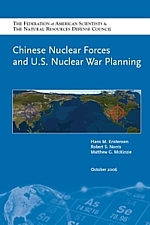
An incipient nuclear arms race is emerging between China and the United States, according to a new report published today by the Federation of American Scientists and the Natural Resources Defense Council.
The 250-page report, Chinese Nuclear Forces and U.S. Nuclear War Planning, outlines the status and possible future development of China’s nuclear weapons, describes the history of U.S. nuclear targeting of China, and simulates nuclear strike scenarios between the two nuclear powers.
Both countries are pointing to the other as an excuse to modernize nuclear forces. In the United States the report finds that the Pentagon, the intelligence community, congressional committees, private institutes and the news media frequently overstate Chinese capabilities or present dramatic new developments out of context to underscore a threat.
China, for its part, cloaks its nuclear forces in a veil of secrecy, which creates suspicion and fear in other countries about Chinese intentions.
The report, which is based on analysis of declassified and unclassified U.S. government documents as well as commercial satellite images of Chinese installations, urges both countries to take steps to halt and reverse the tension and military build-up.
China’s Nuclear Forces
The report estimates that China has a stockpile of approximately 200 nuclear warheads, of which roughly 140 are deployed. About 100 of the warheads are for use by ballistic missiles while 40 are bombs for delivery by aircraft.
Given the almost complete lack of information from Chinese authorities about the size and composition of the stockpile, the FAS/NRDC estimate largely builds on analysis of declassified and unclassified assessments produced by U.S. government agencies over the years. Those assessments have been fraught with inaccuracy and inconsistency, the report finds, with a strong predisposition towards making worst-case predictions for stockpile size, weapons range and deployment.
This tendency continues today, and the report takes issue with the core prediction made by the intelligence community that says that the number of Chinese warheads primarily targeted against the continental United States will increase from 20 today to 75-100 warheads by 2015. The prediction assumes 40-55 new DF-31A missiles will be deployed over the next nine years in addition to the DF-31 and JL-2 missiles, a questionable estimate given that the DF-31A has not even been flight tested.
Chinese Submarines
The report discloses for the first time the number of patrols that Chinese submarines conduct each year. The capability of the Chinese submarines fleet is a hot issue following news media reports earlier this months about a Chinese submarine surfacing undetected near the USS Kitty Hawk carrier battlegroup off Okinawa, claims by the Pentagon that the Chinese navy is expanding its reach deep into the Pacific, and the U.S. Congress’ US-China Commission reporting earlier this month that China “continues to expand” its submarine fleet.
Yet the FAS-NRDC report shows that the Chinese submarine fleet is in steep decline from 120 submarines in the mid-1980s and expected by the U.S. navy to level out around 40 submarines in the next decade. The report shows that Chinese submarines rarely sail on patrol, that the entire submarine fleet in average conducts two patrols per year, that the most patrols conducted in a single year were six (in 2000), and that no patrols were conducted at all in 2005.
The report also reveals that China’s single ballistic missile submarine has never sailed on a nuclear deterrent patrol.
US Nuclear Targeting of China
Through analysis of declassified Pentagon documents, the report finds that U.S. nuclear targeting of China in the past has been considerably more prominent than normally assumed in the public debate. During the 1970s, for example, half of the major nuclear attack options in the U.S. strategic nuclear war plan were aimed at China.
After a hiatus in the 1980s precipitated by a joint U.S.-Chinese stand against the Soviet Union, U.S. nuclear targeting of China has increased after the end of the Cold War. The U.S. navy now bases the majority of its ballistic missile submarines in the Pacific, modernizing their nuclear missiles, and forward-deploying strategic bombers to Guam.
Nuclear Simulations
The report also presents the result of number of simulated nuclear strike scenarios between the two countries, showing that both have more than adequate capability to deter each other. The simulations are striking because they show that regardless of whether the strike is an imprecise Chinese “countervalue” attack on cities, or a highly accurate U.S. “counterforce” attack on military facilities, the result would be tens of millions of innocent civilian casualties.
A Chinese attack with 20 ICBMs would result in as many as 40 million casualties, the report estimates, and blanket large portions of the United States and Canada with radioactive fallout. Likewise, a limited and highly accurate U.S. nuclear attack on China’s 20 long-range ballistic missile silos would result in as many as 11 million casualties and scatter radioactive fallout across three Chinese provinces.
Take Google Earth Trip of Chinese Military Facilities
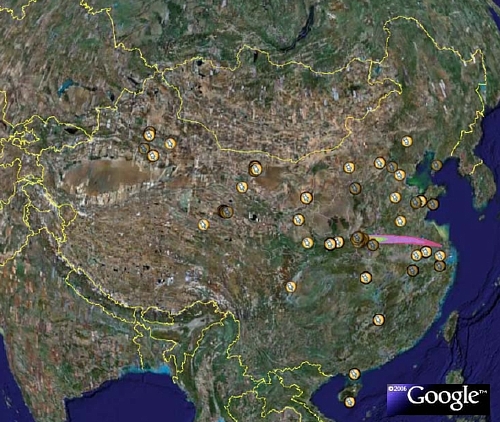 |
|
Download the FAS-NRDC Google Earth file here. |
Making use of the unique capabilities of the free Google Earth program, FAS and NRDC have designed a virtual trip of selected nuclear and military facilities in China. Here is how to use it:
1. Download Google Earth onto your computer.
2. Click here or on the link below the map above to download the FAS-NRDC Google Earth file. The program will ask you to either open in Google Earth or download to your hard drive.
3. When Google Earth has finished loading on your computer, make sure the check-box “Chinese Nuclear Forces and U.S. Nuclear War Planning” in the “Places” window to the left is checked to activate the placemarks.
4. Click once on the first placemark (“Chinese Nuclear Forces and U.S. Nuclear War Planning”) to open the text “bubble” with information.
5. If all the placemarks have not opened automatically, click the “plus-box” to the left of the “check-box” in the “Places” window.
6. Those placemarks with an icon that looks like the Google Earth logo or a file-folder contain additional sub-placemarks. Click on the “plus-box” to open each folder. Note that some air bases contain sub-placemarks for each aircraft.
7. Double-click on each consecutive placemark to zoom in on each facility. Don’t forget to use the “tilt” and “rotate” functions of Google Earth to get a better view.
8. The last two folders contain graphic displays of nuclear strike simulations. These simulations are explained in detail in the Chapter 4 of the report (download from here).
Download: Full Report | Individual Chapters | Google Earth Map
US-China Commission Report Toned Down; Errors Remain

The annual report published Monday by the U.S.-China Economic and Security Review Commission is different – kind of toned-down – compared with the report published in 2005. The Commission hasn’t gone soft on China, and the report continues the strong critique of China that has characterized the Commission since it was established in 2000. But much of the stronger language from the 2005 report, and many of the more questionable claims about Chinese nuclear weapons capabilities, did not make it into the new report.
The toning-down of the report follows reports earlier this year that the Pentagon’s annual report on Chinese military capabilities was also softened before publication. A call to the US-China Commission office about why the changes were made was not answered.
Noticeable changes in the 2006 report compared with last year include:
* Deletion of the top recommendation that Congress should “encourage increasing U.S. military capabilities in the Western Pacific in response to growing Chinese capabilities.” This blunt call for an arms race is replaced in the new report with a recommendation that DOD includes in its annual report on China’s military power “an assessment of U.S. weapon systems, force structure, basing, doctrine, and tactics in order to maintain a favorable balance of military power in the region” to ensure that the Pentagon can beat the Chinese in a war.
* Deletion of the erroneous claim that China’s next-generation long-range nuclear ballistic missiles will carry multiple warheads. In last year’s report, this claim was based on two non-authoritative sources: a Heritage Foundation brochure and a Japanese news paper article. The U.S. intelligence community, in contrast, has consistently stated that the missiles will be equipped with single warheads.
* Deletion of the erroneous claim that the Chinese navy has nuclear-armed anti-ship cruise missiles.
* The section “Expansion of China’s Nuclear Forces” is now simply called “Missiles.”
While it is a positive development that the Commission has made these changes, the 2006 report by no means looses sight of the Commission’s mandate to report on China’s military modernization and force deployments. Yet there are several claims in the 2006 report that stand out:
* A big one is that China is said to be pursuing measures to “control” the seas in the “Western Pacific.” But as anyone with just a little knowledge of naval operations understands, gaining “control” over an area requires superior capabilities, something China simply does not have now nor is likely to acquire in the foreseeable future. It is one thing to try to achieve “control” of a limited coastal area between China and Taiwan, but quite another to achieve it in the “Western Pacific” as the Commission says.
* Another claim is that China “continues to improve its older intercontinental ballistic missiles,” which, although true, forgets to mention that this particular improvement of the DF-5 missile has been underway since the 1980s and is now finally nearing completion. Slow and long-term is typical for Chinese nuclear programs.
* The Commission also claims that a new missile currently under development – the DF-31A – “will be the first Chinese ICBM capable of hitting Washington, DC.” Not so, unless the U.S. intelligence community has been wrong or lying for 30 years. According to numerous declassified documents, unclassified official reports and official statements made by the intelligence community, China has been targeting all of the United States with the DF-5 since the early 1980s. But the suggestion that DF-31A has a longer range than DF-5 echoes information contained in the 2006 DOD report on China’s military forces. A map in that report showed a DF-5 range considerably shorter than shown on a map in the 2005 DOD report. Whether the U.S. intelligence community has decreased its estimate for the DF-5 range or simply made an error (that everyone keeps repeating) is unknown.
* The Commission report also claims that China “continues to expand” its submarine fleet, when, in fact, it is not. On the contrary, China’s submarine fleet is in sharp decline, down from approximately 120 boats in the mid-1980s to about 60 today. While the Commission report focuses on highlighting China’s acquisition of new submarines, U.S. Naval Intelligence anticipates that the Chinese submarine fleet will level out at around 40 boats.
Over the past two years, military-to-military contact has increased between China and the United states, not least thanks for the efforts of Admiral William J. Fallon, the commander of U.S. Pacific Command. Likewise, U.S. Strategic Command has begun direct conversions with its Chinese counterpart about the role of nuclear weapons. The U.S.-China Commission report acknowledges this development, but complains that the military-to-military contacts “may disproportionally benefit the” Chinese by increasing their knowledge of U.S. military capabilities.
To ensure that the United States doesn’t t fall behind, the Commission has a solution: increase U.S. spying against China. This is a curious recommendation, given that allegations about Chinese spying against the United States is what gave birth to the U.S.-China Commission in the first place.
The overall impression I get from the Commission’s report is that it spends too much time on reporting dramatic new developments and too little time on analyzing what its all means. To that end it is important not only to get the facts right but also to describe them in context. China is modernizing its military forces – as are virtually all of its neighbors including the United States. All these players are engaged in a dangerous game of deterrence that creates fear and suspicion and triggers requirements for better weapons and bolder war plans.
The challenge for the United States and its allies in the region is not, as the Commission seems to believe, to continue to deploy more and better weapons to counter China’s military modernization, but to figure out how to create a foreign policy that ends the mistrust.
|
New report |
China Test-Launches New Ballistic Missile
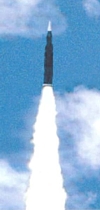
China has test launched a DF-31 long-range ballistic missile, according to a report by the Russian news agency ITAR-TASS. The missile was said to have been launched from the Wuzhai launch site on Monday night.
The DF-31 has been under development since the 1980s and Monday’s flight test appears to be the sixth flight test of the missile since 1999. The U.S. Department of Defense predicted in 2002 that the DF-31 would be deployed “before mid-decade,” but that didn’t happen. The current DOD prediction is that deployment may happen this year. Some web sites erroneously say the missile is already operational.
The DF-31 forms the core of China’s current modernization of long-range nuclear ballistic missiles. Two modifications of the DF-31 are under development. The road-mobile DF-31A has a longer range (possibly up to 12,000 km), and the 8,000+ km range Julang-2 is intended to arm China’s next generation of ballistic missile submarines (Jin-class).
There is considerable confusion and uncertainty about the capability of the DF-31. Early reports predicted a range of at least 8,000 km (4,875 miles), but the latest DOD estimate is 7,250+ km (4,500+ miles). China has not yet tested the DF-31 to the full range reported by the DOD. Tuesday’s test launch impacted in the Takla Makan Desert some 2,500 km west of Wuzhai. If the range is 7,250+, the DF-31 will not be able to target the entire continental United States, only the most northwestern parts. Its main role may be against Russia, India, as well as U.S. facilities in the Pacific including Hawaii and Guam.
Another confusion concerns the payload. Despite widespread speculation among private analysts and media that the new missiles will carry multiple warheads, the U.S. intelligence community anticipates that all three missile types will carry a single warhead each.
Later this month (September), FAS and the Natural Resources Defense Council will publish a joint report about Chinese nuclear forces and U.S. nuclear targeting of China. The report uses high-resolution satellite images and declassified documents to describe the nuclear relationship between China and the United States.
See also: Elusive Chinese Submarine Cave Spotted | Nuclear Notebook on Chinese Nuclear Forces
US Air Force Publishes New Missile Threat Assessment
 The Air Force has published a new report about the threat from ballistic and cruise missiles. The new report, Ballistic and Cruise Missile Threat, presents the Air Force National Air and Space Intelligence Center’s (NASIC) assessment of current and emerging weapon systems deployed or under development by Russia, China, India, Pakistan, North Korea, Iran, Syria and others.
The Air Force has published a new report about the threat from ballistic and cruise missiles. The new report, Ballistic and Cruise Missile Threat, presents the Air Force National Air and Space Intelligence Center’s (NASIC) assessment of current and emerging weapon systems deployed or under development by Russia, China, India, Pakistan, North Korea, Iran, Syria and others.
Among the news in the report is a different and higher estimate for China’s future nuclear arsenal than was presented in the previous NASIC report from 2003. Whereas the previous assessment stated that China in 15 years will have 75-100 warheads on ICBMs capable of reaching the United States, the 2006 report states that this number will be “well over 100” warheads. NASIC also believes that a new Chinese cruise missile under development will have nuclear capability.
Also new is that NASIC reports that the Indian Agni I ballistic missile has not yet been deployed despite claims by the Indian government that the weapon was “inducted” into the Indian Army in 2004. Contrary to claims made by some media and experts, the NASIC report states that the Indian Bramos cruise missile does not have a nuclear capability. The Babur cruise missile under development by Pakistan, however, is assessed to have a nuclear capability.
A copy of the report, which was published in March 2006 and recently obtained by the Federation of American Scientists, is available in full along with previous versions here.
Chinese Military Power: Can We Avoid Cold War?
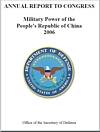 The Pentagon yesterday released its annual warning of the growing Chinese military threat. This year’s version continues the refrain from previous years and reiterates the conclusion from the recent Quadrennial Defense Review that China now is seen as the top large-scale military threat to the United States.
The Pentagon yesterday released its annual warning of the growing Chinese military threat. This year’s version continues the refrain from previous years and reiterates the conclusion from the recent Quadrennial Defense Review that China now is seen as the top large-scale military threat to the United States.
The signs of a Chinese threat are all there: An increasing defense budget that may equal half of ours in 20 years, new long-range mobile nuclear missiles that will be harder for us to destroy, an increase in the number of nuclear warheads that can hit the United States to perhaps as much as two percent of the warheads we can hit them with, new cruise missiles similar to the hundreds of cruise missile we have deployed in the region for decades, warships that may be able to disturb the unhindered operations of our carrier battle groups and surface action groups, a handful of nuclear-powered attack submarines that our 30 nuclear-powered attack submarines in the Pacific will have to sink too, more fighters and bombers that will be harder for the hundreds of advanced fighters we have deployed in the region for decades to shoot down.
This year’s Pentagon report dedicates more space than previous versions to discussing the big unknown: will China abandon its policy not to use nuclear weapons first? Of cause, there is “no evidence that this doctrine has actually changed” and China’s senior leadership assured Rumsfeld in 2005 that it “will not change,” the report states. Yet the attention this issue gets in the report suggests that the Pentagon suspects a change is underway. The circle of “military and civilian national security professionals” that discuss the value of the no-first-use policy “is broader than previously assessed,” the report hints.
Just imagine if China had a nuclear policy like the United States: a first-use nuclear doctrine with highly-accurate flexible nuclear forces on high alert, many of them forward deployed, capable of conducting a decapitating preemptive first strike. That would be highly destabilizing.
So let’s try not to get to that situation. Unfortunately, after having targeted China for 50 years, the Pentagon is reacting to China’s military modernization in the old-fashioned way: moving the majority of its nuclear ballistic missile submarines into the Pacific, increasing the number of attack submarines operating in the region, and forward-deploying bombers and cruise missiles to Guam. It has even built a whole new war plan, known as Operations Plan (OPLAN) 5077, according to Willliam Arkin, to defend Taiwan which includes options for attacks on the Chinese mainland, even the potential use of nuclear weapons.
Last time we got into this tit-for-tat game with a large military power it took 50 years, trillions of dollars, and several nuclear crises to get out. The Pentagon’s report on China’s military modernization should warn us that it is important that the White House and Congress take charge of U.S.-Chinese relations so we avoid a new Cold War in the Pacific.
See also: Chinese Nuclear Forces, 2006 | China’s Nuclear Submarine Cave
Chinese Nuclear Weapons Profiled
 The Chinese nuclear stockpile appears to be only half as big as previously thought, according to a new overview published in the Bulletin of the Atomic Scientists. Up to 130 warheads may be deployed out of a total stockpile of some 200 warheads. Several new weapon systems are under development which the Pentagon says could increase the arsenal in the future, but past US intelligence projections have proven highly inflated and inaccurate. The new overview will be followed by a more detailed report published by the Federation of American Scientists and the Natural Resources Defense Council this spring.
The Chinese nuclear stockpile appears to be only half as big as previously thought, according to a new overview published in the Bulletin of the Atomic Scientists. Up to 130 warheads may be deployed out of a total stockpile of some 200 warheads. Several new weapon systems are under development which the Pentagon says could increase the arsenal in the future, but past US intelligence projections have proven highly inflated and inaccurate. The new overview will be followed by a more detailed report published by the Federation of American Scientists and the Natural Resources Defense Council this spring.
Chinese Nuclear Forces and U.S. Nuclear War Planning
Hans M. Kristensen and two analysts from the Natural Resources Defense Council examine the debate over China’s modernization of its nuclear forces, review the composition and possible future development of the Chinese nuclear arsenal, describe past and current U.S. nuclear targeting of China, and use government software to simulate the effects of Chinese and U.S. of nuclear attacks. The report (PDF) concludes that both countries use the other as an excuse to modernize their nuclear forces, and recommends that urgent steps are needed by both sides to halt and reverse a nuclear arms race.
Elusive Chinese Submarine Cave Spotted
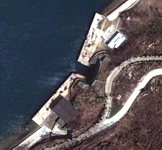 A long-rumored but never before seen Chinese underground submarine base is shown for the first time in a new article written by analysts from the Federation of American Scientists and Natural Resources Defense Council. The article, published in Imaging Notes, shows newly acquired satellite images of the submarine base, three air bases, and China’s nuclear weapons lab at Mianyang.
A long-rumored but never before seen Chinese underground submarine base is shown for the first time in a new article written by analysts from the Federation of American Scientists and Natural Resources Defense Council. The article, published in Imaging Notes, shows newly acquired satellite images of the submarine base, three air bases, and China’s nuclear weapons lab at Mianyang.
A front page article in Washington Times was headlined “Commercial photos show Chinese nuke buildup,” but both the cave and submarines have existed for nearly three decades. Only now, thanks to commercial satellites, can the public see them.
The Imaging Notes article is a snapshot from a larger FAS/NRDC report on US-Chinese nuclear relations scheduled for publication later this spring.